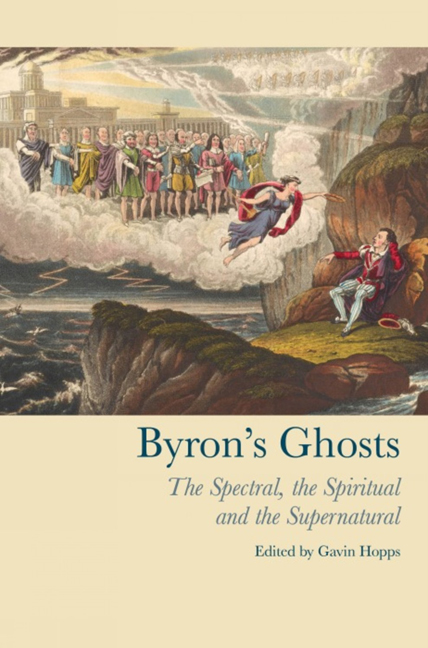Book contents
- Frontmatter
- Dedication
- Contents
- Acknowledgements
- Texts and Abbreviations
- Introduction: The Re-Enchantment of Romanticism
- Chapter 1 Determining Unknown Modes of Being: A Map of Byron's Ghosts and Spirits
- Chapter 2 Shades of Being: Byron and the Trespassing of Ontology
- Chapter 3 Byron and the Noonday Demons
- Chapter 4 Conjuration and Exorcism: Byron's Spectral Rhetoric
- Chapter 5 Byron avec Sade: Material and Spectral Violence in Childe Harold's Pilgrimage Canto IV
- Chapter 6 ‘’Twixt Life and Death’: Childe Harold's Pilgrimage, Don Juan and the Sublime
- Chapter 7 Byron, Ann Radcliffe and the Religious Implications of the Explained Supernatural in Don Juan
- Chapter 8 The Haunting of Don Juan
- Chapter 9 Being neither Here nor There: Byron and the Art of Flirtation
- Afterword: Blowing on a Dead Man's Embers: Byron's Biographical Ghosts
- Bibliography
- Notes on Contributors
- Index
Introduction: The Re-Enchantment of Romanticism
- Frontmatter
- Dedication
- Contents
- Acknowledgements
- Texts and Abbreviations
- Introduction: The Re-Enchantment of Romanticism
- Chapter 1 Determining Unknown Modes of Being: A Map of Byron's Ghosts and Spirits
- Chapter 2 Shades of Being: Byron and the Trespassing of Ontology
- Chapter 3 Byron and the Noonday Demons
- Chapter 4 Conjuration and Exorcism: Byron's Spectral Rhetoric
- Chapter 5 Byron avec Sade: Material and Spectral Violence in Childe Harold's Pilgrimage Canto IV
- Chapter 6 ‘’Twixt Life and Death’: Childe Harold's Pilgrimage, Don Juan and the Sublime
- Chapter 7 Byron, Ann Radcliffe and the Religious Implications of the Explained Supernatural in Don Juan
- Chapter 8 The Haunting of Don Juan
- Chapter 9 Being neither Here nor There: Byron and the Art of Flirtation
- Afterword: Blowing on a Dead Man's Embers: Byron's Biographical Ghosts
- Bibliography
- Notes on Contributors
- Index
Summary
immaterialism's a serious matter
(Byron, DJ, XVI, 114)‘Grim reader! did you ever see a ghost?’ (XV, 95). What relevance does Don Juan 's question have for contemporary readers of Byron? What is to be gained from focusing attention on the spectral, the spiritual and the supernatural in the work of this worldly and sceptical poet? As a way of contextualizing this volume's concerns, ahead of an outline of the individual chapters, this introduction seeks to explain why ghosts are of interest in a postmodern world and why this surprising renewal of interest is of significance for Romantic studies in general, and readers of Byron in particular.
I
If the notion of being ‘a little bit dead’ was memorably ridiculed by Monty Python's Parrot Sketch, it has been at least as effectively redeemed by the writings of Jacques Derrida. According to Derrida – who claimed that ‘the logic of spectrality’ is ‘inseparable from the very motif […] of deconstruction’ – the ghostly has hitherto eluded the scholarly gaze, since a commitment to the categories of classical ontology pre-emptively rules out its manner of appearing. As Peter Buse and Andrew Stott explain:
the necessary distance of scholarly ‘objectivity’ […] constitutes an avoidance of spectrality, since to figure the ghost in terms of fact or fiction, real or not-real, is to attribute to it a foundational ground, either a positive or negative facticity that the notion of ghostliness continually eludes.
In adumbrating a modality that is irreducible to the alternatives of living and not living, presence and absence, real and imaginary etc., Derrida has hospitably made room for such ontological unhousedness.
Derrida is of course not alone in this newfound hospitality towards the ghostly. Indeed, Theory – that amorphous, quasi-agentive apotheosis – is positively teeming with spectres, and it is possible to find evidence of the ‘spectral turn’ in most of the major movements and schools. Examples include: Lacan's psychoanalytical exposition of an uncanny site ‘between two deaths’…
- Type
- Chapter
- Information
- Byron's GhostsThe Spectral, the Spiritual and the Supernatural, pp. 1 - 29Publisher: Liverpool University PressPrint publication year: 2013



